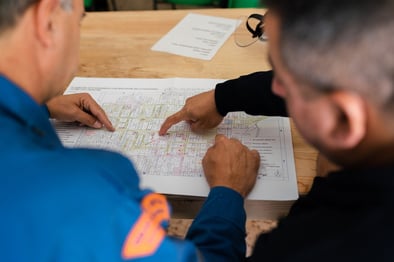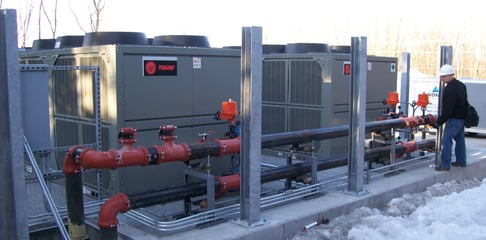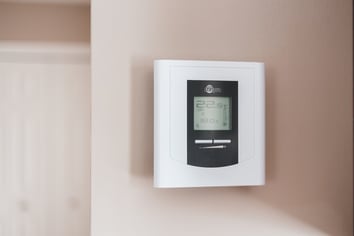 I was recently involved in a commissioning (Cx) project that involved an owner’s training scope that went beyond the general Cx scope or LEED requirements and wanted to share my insights into this experience. For our standard training review scope, we ensure requirements for training are included in the specifications and review each subcontractor’s training plan ahead of the training session to ensure it will meet the requirements of the project contract documents. This also provides an opportunity for the owner to review the plan ahead of the training and indicate whether there are other items they’d like to see covered. However, this training review approach leaves a gap in the process, as the level of detail provided during the actual training session may not align with the expectations of the Cx agent or the owner/operator, and the starting expertise of the building operator varies greatly project to project.
I was recently involved in a commissioning (Cx) project that involved an owner’s training scope that went beyond the general Cx scope or LEED requirements and wanted to share my insights into this experience. For our standard training review scope, we ensure requirements for training are included in the specifications and review each subcontractor’s training plan ahead of the training session to ensure it will meet the requirements of the project contract documents. This also provides an opportunity for the owner to review the plan ahead of the training and indicate whether there are other items they’d like to see covered. However, this training review approach leaves a gap in the process, as the level of detail provided during the actual training session may not align with the expectations of the Cx agent or the owner/operator, and the starting expertise of the building operator varies greatly project to project.
When a building owner or operator is extremely familiar with mechanical and electrical systems and is already comfortable operating the building controls system, a limited training scope can certainly be adequate. In this situation, the building operator just needs to be taught the specifics of newly installed equipment. This is often the case in larger institutions such as universities and hospitals where the facilities teams are used to working with a wide variety of equipment and system types, monitoring, or making adjustments to their controls on a weekly or daily basis, and where there is very little occupant level control.
However, there are far more buildings we commission where the building operator is new to the equipment type, wasn’t included in the design decisions, may have never worked with a building automation system (BAS), or where the controls strategy implemented is vastly different from anything they’ve encountered before. In these cases, taking the time to properly train building operators is of extreme importance.
 The project I alluded to at the beginning of this blog post was a prime example of how a Cx agent can provide a high-level training to help tie together the project for the owner, resulting in a better understanding of their systems. Subcontractor-provided training often focuses solely on the operation of specific pieces of equipment, but for most projects there is no training provided on how the systems should operate as a whole. This project was a new construction school where our Cx scope included the development of a detailed systems manual, a user’s guide, and time for onsite training. The systems manual described the building’s equipment, how that equipment fit into the larger systems, how the systems were supposed to operate, and how the systems interacted with each other. This was used as the basis of onsite training to review the intended building operations with the facilities team. This training was the first time the facilities team had received an explanation of how the building mechanical, electrical, and plumbing systems were configured and the intent behind their operation even though the building had been turned over a couple months previously.
The project I alluded to at the beginning of this blog post was a prime example of how a Cx agent can provide a high-level training to help tie together the project for the owner, resulting in a better understanding of their systems. Subcontractor-provided training often focuses solely on the operation of specific pieces of equipment, but for most projects there is no training provided on how the systems should operate as a whole. This project was a new construction school where our Cx scope included the development of a detailed systems manual, a user’s guide, and time for onsite training. The systems manual described the building’s equipment, how that equipment fit into the larger systems, how the systems were supposed to operate, and how the systems interacted with each other. This was used as the basis of onsite training to review the intended building operations with the facilities team. This training was the first time the facilities team had received an explanation of how the building mechanical, electrical, and plumbing systems were configured and the intent behind their operation even though the building had been turned over a couple months previously.
As another example, I was speaking to a facilities team lead who was lamenting over the fact that one of their new buildings was not performing as expected because they kept needing to make controls overrides. The system and controls design were significantly more modern compared to other buildings at the site, so the building operation was a whole new world for the facilities team. This should have been recognized during the building design so that the construction team would be prepared to provide a more thorough training than they may have otherwise. Instead, when the building was constructed, the facilities team was not provided adequate training to understand the reasoning behind the new control sequences or which parameters could be adjusted without causing other issues, resulting in a BAS full of overrides and spaces full of occupant comfort issues. If a more extensive training and systems operation description had been provided, the facilities team would be better prepared to operate the system as the design intended. An even better solution would be to include the facilities team in design decisions, but that’s another blog post for another day.
 In addition to building operator training, there is always some level of training needed for building occupants that is rarely, if ever, provided. Occupants need to be taught how their lighting and temperature controls (i.e. controllable thermostats) are supposed to function, especially as these systems become more complicated. For example, if there is a space with heat pumps and backup fin tube radiation with separate thermostats, does the person using this room know that they should make sure the thermostat for the fin tube is kept as low as possible during the cooling season to prevent simultaneous heating and cooling? In my experience the answer to this and similar questions is consistently the same - no. Providing occupants with a simple, easily understandable users’ guide that hangs in their space or is easily accessible online or on the business’s network can help mitigate complaints and questions by providing a general overview of the system, describing what sorts of things the occupant can control from their thermostat and/or lighting interface, and providing a list of FAQs with clear responses.
In addition to building operator training, there is always some level of training needed for building occupants that is rarely, if ever, provided. Occupants need to be taught how their lighting and temperature controls (i.e. controllable thermostats) are supposed to function, especially as these systems become more complicated. For example, if there is a space with heat pumps and backup fin tube radiation with separate thermostats, does the person using this room know that they should make sure the thermostat for the fin tube is kept as low as possible during the cooling season to prevent simultaneous heating and cooling? In my experience the answer to this and similar questions is consistently the same - no. Providing occupants with a simple, easily understandable users’ guide that hangs in their space or is easily accessible online or on the business’s network can help mitigate complaints and questions by providing a general overview of the system, describing what sorts of things the occupant can control from their thermostat and/or lighting interface, and providing a list of FAQs with clear responses.
Owner training needs to correspond with the starting level of the building operator, and building occupants need to be provided with training as well. Asking these questions at the start of and over the course of the project can help the commissioning agent ensure the training plans will cover the depth needed for successful building turnover.
- Does the building operator understand how the systems are supposed to function and interact?
- Have they worked with the types of equipment installed before? If not, do they have a basic understanding of how the equipment operates?
- Does the operator know what alarms the equipment or systems provide and what they should do in the case of each one?
- Has the controls strategy been explained to the building operators?
- BAS specific
- Have they used a BAS before? If not, does the controls contractor scope include a beginner training on how to use the system?
- Does the operator know how to change schedules, setpoints, etc.?
- Does the operator know which setpoints can be changed as needed, and which should be left alone except in emergency?
- Have building occupants been taught how the systems in their spaces work?
- Do they know how to control their temperature settings?
- Do they know how to operate the lighting in the space, especially if it’s a networked lighting system?
- Have the system limitations been explained (i.e. temperature ranges, temperature setbacks during unoccupied hours, etc.)?
- Have any system/control “quirks” they should be aware of been explained (for example, they may need to wait a few minutes for a thermostat to communicate with a heat pump, they may need to coordinate settings if there are multiple thermostats in the space, or their space may be on a heating/cooling zone where one thermostat controls multiple rooms)?
- Have they had the opportunity to ask questions? Do they know who to contact with future questions or about any issues that arise?
If you are a building owner or operator working on a new construction or major renovation project or have an existing building that your team struggles operating effectively, Cx Associates can work with you and your team to develop and provide a robust training program. We want to help you ensure your building is operating as intended, which can reduce both energy use and maintenance staff headaches.


